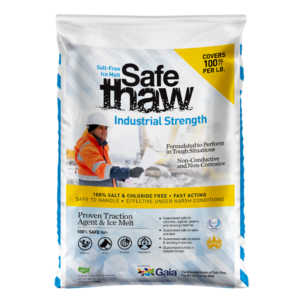6 Effective Ways To Get Your Car Unstuck From Ice

How to get car unstuck from ice is a common challenge during the winter months. Knowing how to get a car unstuck from ice is essential for any driver facing icy conditions. This guide provides six effective methods to free your vehicle, discussing the limitations of traditional solutions like sand and kitty litter, and emphasizing the advantages of using a specialized traction agent like Walk On Ice.
1. Assess The Situation
The first step in understanding how to get car unstuck from ice is to assess the situation. Determine how deeply embedded your car is in the ice and examine the area around your tires. This will help you choose the most effective strategy to free your vehicle.
2. Clear Ice And Snow
Before attempting any maneuvers, clear away as much snow and ice as possible from around your tires. This can reduce resistance and make it easier for your tires to gain traction. A shovel or similar tool can be very useful for this purpose.
3. The Downside Of Using Sand And Kitty Litter
Many people turn to sand or kitty litter for traction under their tires. However, these materials have their drawbacks. Sand can scatter easily and may not provide sufficient grip on ice. Kitty litter, when wet, can become clumpy and slick, possibly worsening the conditions rather than improving them.
4. Rock The Vehicle Gently
A tried and tested method is to gently rock your vehicle back and forth. Shift between forward and reverse gears to create a rocking motion. This can help your tires gain enough momentum to move out of the icy patch.
5. Deflate Tires Slightly
Reducing tire pressure slightly increases the tire’s surface area in contact with the ground, which can improve traction. However, be sure to re-inflate your tires to the correct pressure as soon as possible to avoid tire damage.
6. Use Walk On Ice For Instant Traction
In situations where traditional methods fail, Walk On Ice is a reliable solution. It provides instant traction on all icy surfaces, especially effective when salt and ice melts are slow to act or ineffective, such as on black ice. Walk On Ice’s formula allows it to absorb the liquid layer on ice, creating a stable, non-skid surface.
Get ready for winter with Walk On Ice instant traction on snow and ice
Benefits Of Using Walk On Ice
Walk On Ice Is 100% Natural And Safe For Pets, People, And Your Property, Offering A Significant Advantage Over Other De-Icing Methods. It Is Effective In Extremely Low Temperatures, Down To -35 Degrees Celsius, Making It A Versatile Solution For Various Winter Conditions.
Looking At The Bigger Picture: The Pros And Cons Of Using Sand On Roads
When we talk about traction, sand for traction on ice is one of the oldest tricks in the book. Cities and towns spread it over icy roads every winter, and many homeowners copy the same idea for their driveways. But does it always help?
Here’s the breakdown. On the plus side, sand can immediately provide a gritty layer on top of the ice. That makes it easier for tires to bite into the surface and for boots to get some grip. It’s cheap, widely available, and feels like a “do-it-yourself” fix.
But there are downsides. Sand doesn’t actually melt ice, so once traffic drives over it or wind scatters it, you’re back to square one. It can also clog drains, pile up in yards, and create a mess when spring finally arrives. Road crews spend millions cleaning it up every year. So while it has its place, sand is more of a temporary crutch than a lasting solution.
How To Get A Car Out Of Ice Without Making It Worse
So, you’ve cleared snow and tried rocking the car, but the tires are still spinning. Many drivers panic and start flooring the gas pedal, but that often digs the tires deeper into the icy rut. The smarter move is to ask: what’s the best way for how to get car out of ice without turning a tough spot into a nightmare?
Instead of brute force, think strategy. Lowering the tire pressure slightly can help, but it’s not a magic fix. Positioning traction aids—like floor mats, pieces of carpet, or even cardboard—under the tires can sometimes give you that first bite. The issue is that most of these items slip out after one attempt. That’s where Walk On Ice stands out: unlike mats or kitty litter, it doesn’t slide away. It locks into the ice itself, giving you multiple chances until your car is free.
Is Kitty Litter Really The Best Choice For Snow Traction?
A lot of people swear by kitty litter, but the real question is: is it the best kitty litter for snow traction or just a winter myth that won’t go away? Regular clay-based litter does have an abrasive texture, which means it can sometimes help tires grab the surface. But once it absorbs water, it clumps together and actually creates more slipperiness. Imagine trying to drive on wet mud—that’s essentially what happens.
Some silica-based or non-clumping litters may work better, but they’re still not designed for traction. They’re made for cats, not cars. Plus, tracking litter all over your driveway, inside your car, and around your yard isn’t exactly ideal. For quick, mess-free, and effective traction, dedicated products like Walk On Ice make a lot more sense. It’s the difference between improvising and having the right tool for the job.
Why Smart Drivers Mix Methods
The smartest approach isn’t always “choose one and forget the rest.” Sometimes, mixing methods gives you the best outcome. For example:
- Use sand or kitty litter for short-term grit if you’re in a pinch.
- Keep Walk On Ice in your glove compartment for emergencies when nothing else works.
- Combine careful rocking techniques with a traction aid for the fastest escape.
By thinking ahead and having multiple options, you’re not stuck hoping one method will save the day. Winter throws curveballs, and layering your solutions is the way to stay ahead.
Conclusion: Traction Isn’t About Luck—It’s About Choices
At the end of the day, knowing how to get car out of ice comes down to preparation and making the right choices. Sand has its place, but the pros and cons of using sand on roads show why it’s far from perfect. Kitty litter sounds handy, but even the best kitty litter for snow traction isn’t a consistent solution.
Walk On Ice, on the other hand, is built for exactly these moments—whether you’re stuck in a frozen driveway or facing an icy parking lot after work. With its natural ingredients and instant traction, it’s the difference between spinning your wheels in frustration and driving away safely.
So this winter, don’t leave it up to chance. Keep a shovel in the trunk, know the tricks for rocking your car free, and carry Walk On Ice as your reliable backup. Because when the snow piles up and your tires are locked in place, it won’t be luck that gets you moving again—it’ll be preparation, smart choices, and traction you can trust.
Other Ice Melt Products
Safe Paw
The Original and #1 Selling Pet and Child Safe Ice Melt for over 20 years. Guaranteed environmentally safe – will not harm waterways and sensitive wetlands. All products are made in the USA.

Safe Thaw
Imagine an ice melt you can put down and never worry about. It won’t harm pets, kids, and your property. That’s Safe Thaw. Unlike anything else on the market, Safe Thaw can change how winter affects our planet.



